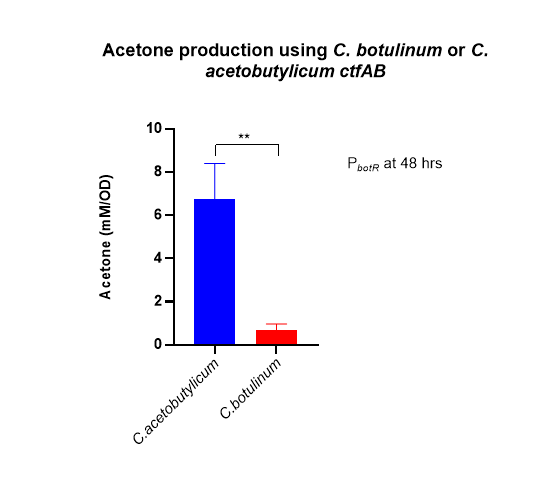Difference between revisions of "Part:BBa K2992033"
| (8 intermediate revisions by 3 users not shown) | |||
| Line 5: | Line 5: | ||
RBS region for the <i>adc</i> gene from <i>C. acetobutylicum</i>. | RBS region for the <i>adc</i> gene from <i>C. acetobutylicum</i>. | ||
| − | |||
===Usage and Biology=== | ===Usage and Biology=== | ||
| + | This parts entry represents the RBS for the acetoacetate decarboxylase <i>adc</i> gene in <i>C. acetobutylicum</i>. The gene product of <i>adc</i> catalyses the decarboxylation of acetoacetate into acetone and CO2. <i>adc</i> is a central component of our acetone production pathway to validate the use of volatile reporters to predict botulinum toxin production following food manufacturing processes. <br><br> | ||
<!-- --> | <!-- --> | ||
| − | <span class='h3bb'> | + | |
| + | ===Characterisation=== | ||
| + | This part is the ribosome binding site for the translation of the <i> adc </i> gene from <i> C. acetobutylicum </i>. This was integrated in to the larger composite parts: [https://parts.igem.org/Part:BBa_K2992028 BBa_K2992028], [https://parts.igem.org/Part:BBa_K2992029 BBa_K2992029], [https://parts.igem.org/Part:BBa_K2992030 BBa_K2992030], [https://parts.igem.org/Part:BBa_K2992034 BBa_K2992034], [https://parts.igem.org/Part:BBa_K2992035 BBa_K2992035] and [https://parts.igem.org/Part:BBa_K2992036 BBa_K2992036]. See [https://2019.igem.org/Team:Nottingham/Results results page]for more <br><br> | ||
| + | |||
| + | Having established the functionality of our chosen promoters. We next assessed the feasibility of using these to drive acetone production in our reporter strains. In our design approach, we rationalized that either <i>C. botulinum</i> [https://parts.igem.org/Part:BBa_K2992003 BBa_K2992003] [https://parts.igem.org/Part:BBa_K2992007 BBa_K2992007] [https://parts.igem.org/Part:BBa_K2992005 BBa_K2992005] or <i>C. acetobutylicum</i>-derived <i>ctfAB</i> [[https://parts.igem.org/Part:BBa_M36581 BBa_M36581]. [https://parts.igem.org/Part:BBa_M36582 BBa_M36582], encoding the A and B subunits of the butyrate-acetoacetate CoA-transferase complex, should permit acetone production. To test this, we transformed pMTL82151 plasmids encoding our acetone pathways using <i>C. botulinum</i> <i>ctfAB</i> [https://parts.igem.org/Part:BBa_K2992029 BBa_K2992029] or <i>C. acetobutylicum</i> <i>ctfAB</i> [https://parts.igem.org/Part:BBa_K2992036 BBa_K2992036], both under the control of P<i>ntnH</i>, into our P<i>botR-botR</i> reporter strain of <i>C. sporogenes</i>. | ||
| + | |||
| + | [[File:CtfAB.PNG]] | ||
| + | <br><br> | ||
| + | The data clearly indicates that <i>ctfAB</i> from <i>C. acetobutylicum</i> was much better suited to providing acetone production capacity to our <i>C. sporogenes</i> reporter strains. These data have provided clear insight into the design strategy for any future exploits of our reporter strains for using acetone production as a model for safely predicting Botulinum neurotoxin production in foodstuffs. | ||
| + | |||
| + | |||
| + | <span class='h3bb'></span> | ||
| + | ===Sequence and Features=== | ||
<partinfo>BBa_K2992033 SequenceAndFeatures</partinfo> | <partinfo>BBa_K2992033 SequenceAndFeatures</partinfo> | ||
| + | ===References=== | ||
| + | |||
| + | Cornillot, E., Croux, C. and Soucaille, P. (1997). Physical and genetic map of the Clostridium acetobutylicum ATCC 824 chromosome. Journal of Bacteriology, 179(23), pp.7426-7434. | ||
<!-- Uncomment this to enable Functional Parameter display | <!-- Uncomment this to enable Functional Parameter display | ||
Latest revision as of 22:18, 21 October 2019
RBS region for the adc gene from C. acetobutylicum.
RBS region for the adc gene from C. acetobutylicum.
Usage and Biology
This parts entry represents the RBS for the acetoacetate decarboxylase adc gene in C. acetobutylicum. The gene product of adc catalyses the decarboxylation of acetoacetate into acetone and CO2. adc is a central component of our acetone production pathway to validate the use of volatile reporters to predict botulinum toxin production following food manufacturing processes.
Characterisation
This part is the ribosome binding site for the translation of the adc gene from C. acetobutylicum . This was integrated in to the larger composite parts: BBa_K2992028, BBa_K2992029, BBa_K2992030, BBa_K2992034, BBa_K2992035 and BBa_K2992036. See results pagefor more
Having established the functionality of our chosen promoters. We next assessed the feasibility of using these to drive acetone production in our reporter strains. In our design approach, we rationalized that either C. botulinum BBa_K2992003 BBa_K2992007 BBa_K2992005 or C. acetobutylicum-derived ctfAB [BBa_M36581. BBa_M36582, encoding the A and B subunits of the butyrate-acetoacetate CoA-transferase complex, should permit acetone production. To test this, we transformed pMTL82151 plasmids encoding our acetone pathways using C. botulinum ctfAB BBa_K2992029 or C. acetobutylicum ctfAB BBa_K2992036, both under the control of PntnH, into our PbotR-botR reporter strain of C. sporogenes.

The data clearly indicates that ctfAB from C. acetobutylicum was much better suited to providing acetone production capacity to our C. sporogenes reporter strains. These data have provided clear insight into the design strategy for any future exploits of our reporter strains for using acetone production as a model for safely predicting Botulinum neurotoxin production in foodstuffs.
Sequence and Features
- 10COMPATIBLE WITH RFC[10]
- 12COMPATIBLE WITH RFC[12]
- 21COMPATIBLE WITH RFC[21]
- 23COMPATIBLE WITH RFC[23]
- 25COMPATIBLE WITH RFC[25]
- 1000COMPATIBLE WITH RFC[1000]
References
Cornillot, E., Croux, C. and Soucaille, P. (1997). Physical and genetic map of the Clostridium acetobutylicum ATCC 824 chromosome. Journal of Bacteriology, 179(23), pp.7426-7434.
